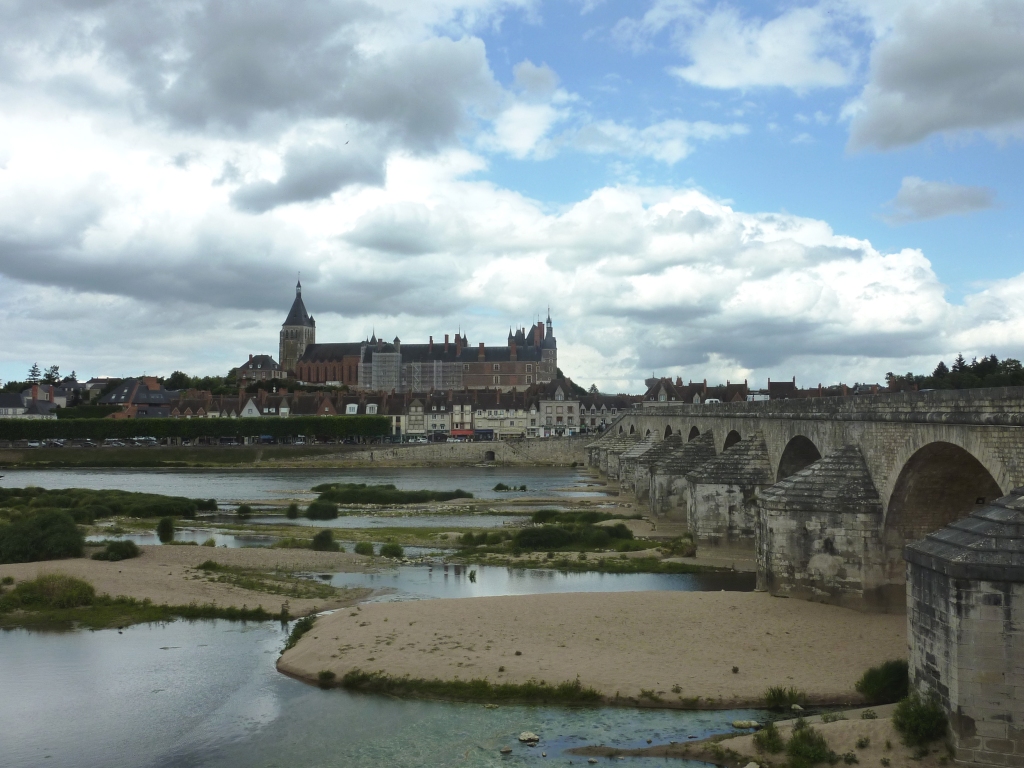The day started with threatening grey skies over the vineyards of Sancerre. The fast descent to Saint-Satur was quickly over despite the rush-hour traffic clogging the streets. Once down on the level of the river, I had the choice of the road - the D955 - or the tow-path. I chose the former for a few kilometres and then switched to the tow-path. I stayed on this until at Boisrond it got increasingly lumpy and, when the rain began in earnest, muddy, so I left it definitively where the cycle-path re-joins the levée.
A brief visit to Cosne-Cours-sur-Loire failed to confirm Higginson's opinion of it as a attractive place. I found nothing to detain me and took the the road along the levée once again.
[
View Sancerre to Sully-sur-Loire in a larger map]
If Cosne-Cours-sur-Loire failed to excite my aesthetic sensibility, then the nuclear power station at Belleville-sur-Loire did even less in this respect. The power-stations along the Loire fill me with vague foreboding. They are huge, intrusive blots on the landscape and around them, everything changes for the worse. Whereas the cycle-track along the levée runs through purely rural scenery, here it hits an industrial desert. The levée disappears, as does the river. Huge wire fences topped with razor-wire and bristling with cameras appear and aggressive signs forbid any sort of photography. The cycle-track skirts the perimeter of the plant and then unaccountably shoots off at a right-angle to the river and doesn't return to it for another few kilometres. The whole area has a dismal feel about it accentuated by the constant roaring of the cooling-towers. I speeded up to get out of sight of the ugly place as quickly as possible.
From Bonny-sur-Loire, the cycle-route follows a very pleasant lane along the river bank and through a
nature-reserve. This seemed the right place for lunch.
After lunch the ride became a little more interesting as it passed through the towns of Briare and Gien.
[
View Sancerre to Sully-sur-Loire in a larger map]
Briare is the more interesting of the two because of its pleasure port and pont-canal. The name 'Briare-le-Canal' doesn't do it justice because it has three canals: the Canal de Briare dating from 1642 when it was Le Canal de Loyre en Seyne, theCanal Latéral à la Loire and the
new link using the pont-canal predictably called Le Canal Neuf. The pont-canal was from its construction in 1896 - with the collaboration of Gustave Eiffel, the creator of the eponymous tower - the longest such aqueduct in the world until 2003, when the Magdeburg aqueduct on the Elbe was completed.
A quick whizz around the town didn't reveal much of note. There's the Eglise Saint-Etienne, a Romano-Byzantine reproduction decorated with locally produced enamels. Some reckon the decorations to be unsuitably profane (signs of the Zodiac etc.) but that's to be expected given the connection between apparent religious revival and money at the time.
From Briare I followed the départementales 957 and 952 straight to Gien and only left the road at the very last moment to ride along a path by the river side.
The remainder of the ride - apart from a detour through Saint-Gondon was spent on the levée and it was from this vantage point that I spotted La Ferme de Gorgeats, my chambre d'hôte. The room was pleasant and spacious, the shower magnificent and the bed just right for an aching back.
(see: http://ferme.des.gorgeats.pagesperso-orange.fr/index.htm)
Since the farm was located a good distance from any town, I was glad to have a meal laid on. This turned out to be the family dinner with Mr and Mrs Coffineau and their trio of very confident and opinionated children. The father, a genuine son of the soil, cultivated potatoes and the mother taught primary school. The children clearly took after their mother who talked incessantly. They ribbed their Dad gently for his peasant ignorance, but he seemed used to it and took it with good humour.











No comments:
Post a Comment